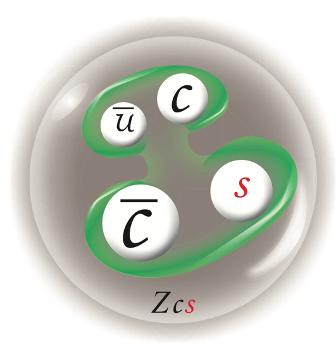
BESIII firstly observed tetraquark state Zcs(3985) (Red shaded area).

In the March 12th, 2021 issue of Physical Review Letters, the particle and nuclear physics team in Lanzhou University and University of Chinese Academy of Sciences reports the discovery of an exotic multi-quark structure, dubbed the Zcs(3985). This is the first candidate for a tetra-quark meson containing hidden-charm with non-zero strangeness. This paper was selected as one of that issue’s "Editors' Suggestion" and prominently featured on the website. The work is supported in part by National Key R&D Program of China, National Natural Science Foundation of China (NSFC) and the Fundamental Research Funds for the Central Universities.
Studies of exotic hadron states, i.e., those that contain more valence-quark constituents than the conventional three-quark baryons and two-quark mesons, provide unique access to details of the non-perturbative effects and color confinement mechanisms in the QCD theory. The existence of hidden-charm tetraquarks with non-zero strangeness, noted as Zcs, was predicted by many theoretical models, but until now, no definitive experimental observations have been reported.
The discovery emerged from analyses of collision data sets taken in 2020. The presence of an exotic state Zcs(3985) in the and mass spectrum made it becomes a strong candidate for the predicted open-strange charmonium-like tetraquark. The Zcs(3985) observation represents a significant breakthrough that opens up a new dimension of the tetraquark meson spectrum.

Schematic diagram of the four-quark state Zcs produced on the electron-positron collider.
Further reading:
The PRL publication:
https://journals.aps.org/prl/abstract/10.1103/PhysRevLett.126.102001
APS synopsis:
https://physics.aps.org/articles/v14/s33
BESIII report:
http://bes3.ihep.ac.cn/doc/4187.html




